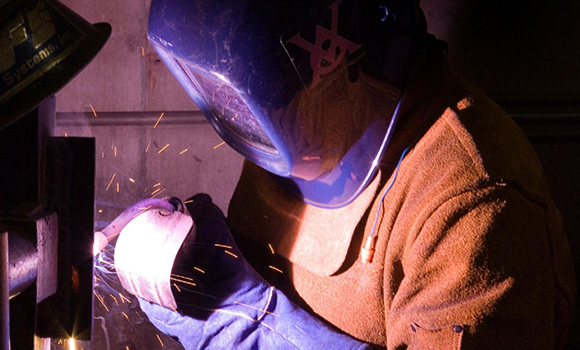
(Photo Credit: California Community Colleges)
The image of a welder is iconic. Sparks fly from a torch and the welder's identity is hidden by an industrial-grade helmet and thick gloves. But before they can embody that all-American vision, welders need very specific hands-on education with the right tools and expert training. Through funds from the California Community Colleges system, a Bay Area collaboration is addressing the region's long-term shortage of qualified workers by preparing students for high-demand, high-wage, and increasingly high-tech careers in welding.
A program at community colleges throughout the San Francisco Bay Area uses funding from a Career Technical Education Enhancement Fund grant in order to the develop industry-approved curriculum and purchase new equipment for welding students.
“One of the myths about welding is that it is easy – everyone can do it,” said Kit O’Doherty, director of the Bay Area Community College Consortium (BACCC).
In reality, learning to weld is very much like learning to play a musical instrument. There are hobbyists and there are concert-level performers. Professional welders are more like the second group. They cut, shape, melt, and join a variety of materials to repair and fabricate a wide range of items. Proficiency requires ample hands-on experience. Before the CTE funding award, students learned metallurgy (the science of heating, combining and shaping metals) only through textbooks.
“There is a growing need for the crafts to have an understanding of metallurgy. This skill set will help the individuals not only while they are welding, but with future jobs in the organization and industry,” said Paul Meltzer, Shell Weld Shop Team Leader at Shell Oil.
“The hands-on portion of training is key to the success of a new welder. Welding is a skill that takes practice in a lab or in the field. It is hard for an individual to learn how to weld without a college or trade school supplying the equipment and materials it takes to practice and get good enough to get a job,” Meltzer explained.
Students benefitting from the new equipment and higher level curriculum, include incumbent workers coming back to school for more training, recent high school graduates seeking a career in welding, adults making a career change or perhaps looking to transition from a job to more of a career.
Meltzer and a number of his colleagues from Bay Area companies have been working with community college faculty in a BACCC Welding Marketplace endeavor to meet the growing need for qualified welders in the regional workforce. Since 2013, the collaborative has established guidelines for the right number of welding programs in the right locations teaching the right skills to meet industry’s need for qualified welders and student desires for rewarding careers with advancement opportunity.
“For me personally it helps see what struggles the colleges have and see ways of helping them close the gaps,” said Meltzer.
Representatives from Shell Oil are joined by a number of industry partners invested in the success of the Welding Marketplace. They include Cal Weld, Contra Costa Water, EBMUD, Ironworkers Apprenticeship, Pacific Steel Casting Co, PG&E, Shell Oil, Union Sanitary District, Sandia National Labs, Aerotek Staffing, Ryco Steel, Santa Clara Valley Water District, Tradeswomen, Inc., All States – Stamping & Mfg. Co., Trans Bay Steel Corporation, and the Dow Chemical Company.
The new CTE funding allows seven community colleges to take the next step by augmenting the current curriculum with the hands-on training so vital to the success of those pursuing a career in welding. Los Medanos College is the lead organization for the program. The schools benefitting from the new funds include Cabrillo College, Chabot College, Hartnell College, Laney College, Las Positas College, Los Medanos College and Solano College. Each college is integrating the new equipment into their program in a way that works best for their students and campus.
Meltzer also sees benefits to the larger community. “Now contractors that support large projects in the bay area are bringing folks from other states to complete their work. This comes with paying per diem and when the jobs are complete, the welders take the money they earned outside of the local communities,” he said.
“With the new funding I hope to see people from the local communities receive the training needed to enter the welding industry,” Meltzer said.
Per O’Doherty, faculty expect about 300 students per year will benefit from the improved programs. Industry projects about the same number of new welding jobs will be created each year and more positions will be available as current workers move into new positions or leave the field.

